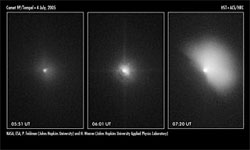Hubble captures Deep Impact’s collision with a comet

This sequence of images shows the comet before and after the impact. The image at left shows the comet 10 minutes before the impact. The encounter occurred at 7:52 a.m. CEST.
The NASA/ESA Hubble Space Telescope captured the dramatic effects of the collision early July 4 between a 370-kilogram projectile released by the Deep Impact spacecraft and comet 9P/Tempel 1.
The sequence of images (files enclosed to this release) shows the comet before and after the impact. The image at left shows the comet 10 minutes before the impact. The encounter occurred at 7:52 a.m. CEST
In the middle image, captured 15 minutes after the collision, Tempel 1 appears four times brighter than in the pre-impact photo. Astronomers noticed that the inner cloud of dust and gas surrounding the comet’s nucleus increased by about 200 kilometres in size. The impact caused a brilliant flash of light and a constant increase in the brightness of the inner cloud of dust and gas.
The Hubble telescope continued to monitor the comet, snapping another image [at right] 62 minutes after the encounter. In this photo, the gas and dust ejected during the impact are expanding outward in the shape of a fan. The fan-shaped debris is travelling at about 1,800 kilometres an hour, or twice as fast as the speed of a commercial jet. The debris extends about 1,800 kilometres from the nucleus.
The potato-shaped comet is 14 kilometres wide and 4 kilometres long. Tempel 1’s nucleus is too small even for the Hubble telescope to resolve.
The visible-light images were taken by the Advanced Camera for Surveys’ High Resolution Camera.
Media Contact
All latest news from the category: Physics and Astronomy
This area deals with the fundamental laws and building blocks of nature and how they interact, the properties and the behavior of matter, and research into space and time and their structures.
innovations-report provides in-depth reports and articles on subjects such as astrophysics, laser technologies, nuclear, quantum, particle and solid-state physics, nanotechnologies, planetary research and findings (Mars, Venus) and developments related to the Hubble Telescope.
Newest articles

Superradiant atoms could push the boundaries of how precisely time can be measured
Superradiant atoms can help us measure time more precisely than ever. In a new study, researchers from the University of Copenhagen present a new method for measuring the time interval,…

Ion thermoelectric conversion devices for near room temperature
The electrode sheet of the thermoelectric device consists of ionic hydrogel, which is sandwiched between the electrodes to form, and the Prussian blue on the electrode undergoes a redox reaction…

Zap Energy achieves 37-million-degree temperatures in a compact device
New publication reports record electron temperatures for a small-scale, sheared-flow-stabilized Z-pinch fusion device. In the nine decades since humans first produced fusion reactions, only a few fusion technologies have demonstrated…





















